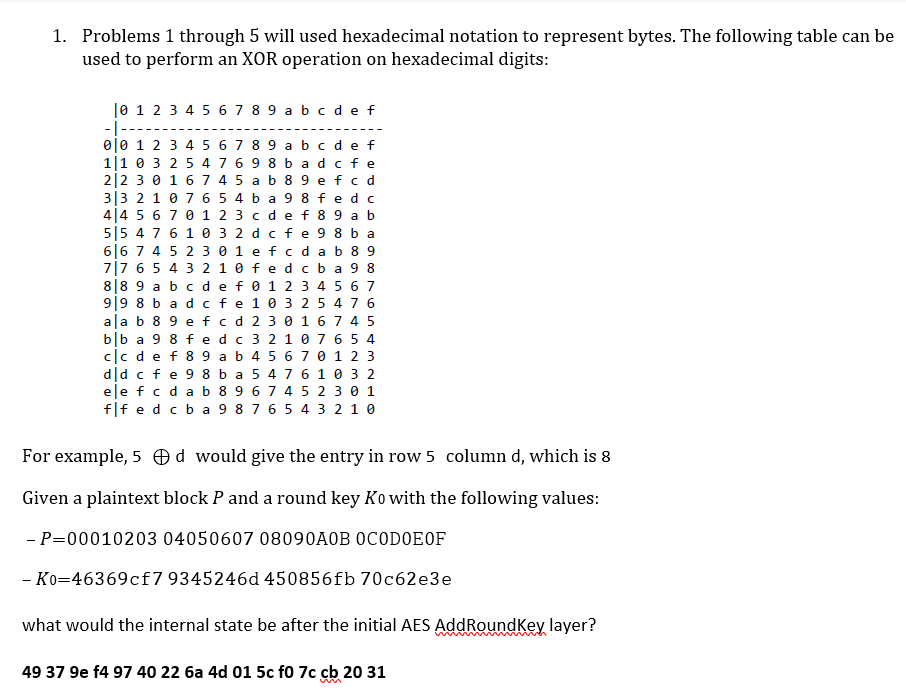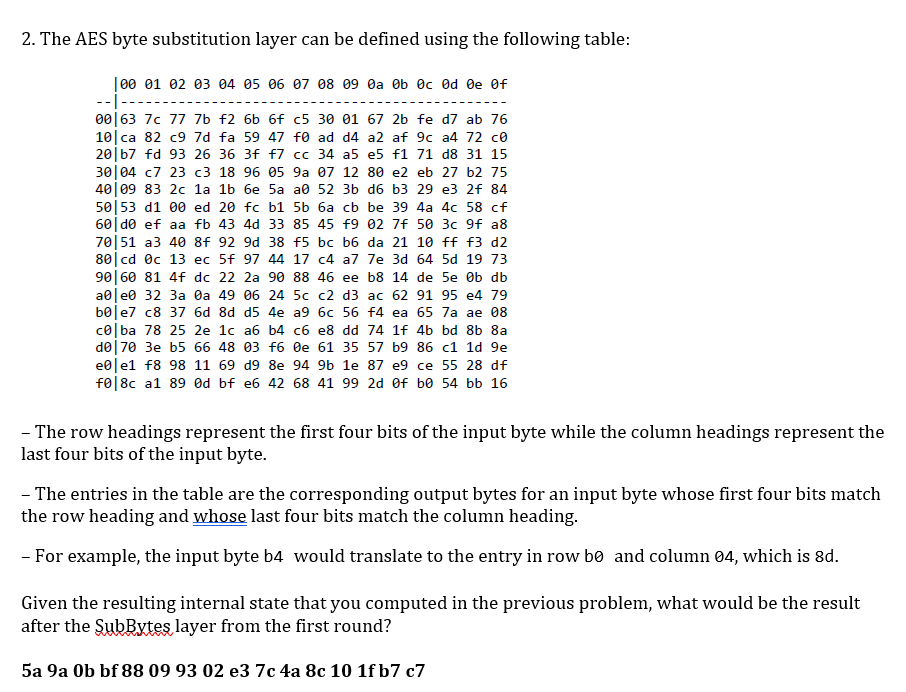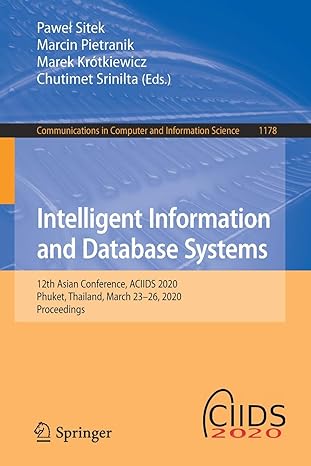I need help with question 4 please. I have 1,2 and 3 done already. Just need 4.



I need help with this question please.

1. Problems 1 through 5 will used hexadecimal notation to represent bytes. The following table can be used to perform an XOR operation on hexadecimal digits: 10 1 2 3 4 5 6 7 8 9 abcdef ------ 0 0 1 2 3 4 5 6 7 8 9 a b c d e f 1 1 0 3 2 5 4 7 6 9 8 b adcfe 212 3 0 16 7 4 5 a b 89efcd 313 2 1 0 7 6 5 4 6 a 9 8 fedc 4|4 5 6 7 0 1 2 3 cd e f 89 a b 515 4 7 6 10 3 2 dcfe 9 8 b a 616 7 4 5 2 3 01efcd a b 8 9 7 7 6 5 4 3 2 1 fedcba 9 8 818 9 a b c d efo 1 2 3 4 5 6 7 919 8 ba dcfe 10 3 2 5 4 7 6 ala b 89efcd 230 16 7 4 5 bb a 9 8 fedc3 210 7 6 5 4 ccdef 89 a b 4 5 6 7 0 1 2 3 dldcfe98 b a 5 4 7 6 1 0 3 2 elefcd a b 8 9 6 7 4 5 2 3 0 1 f|fedcba 9 8 7 6 5 4 3 2 1 0 For example, 5 d would give the entry in row 5 column d, which is 8 Given a plaintext block P and a round key Ko with the following values: - P=000102030405060708090A0B OCODOEOF - Ko=46369cf79345246d 450856fb 70c62e3e what would the internal state be after the initial AES AddRoundKey layer? 49 37 9e f4 97 40 22 6a 4d 01 5c fo 7c cb 20 31 2. The AES byte substitution layer can be defined using the following table: | 01 02 03 04 05 06 07 08 09 0c Od Oe of 00163 7 77 7b f2 6b 6f c5 30 01 67 26 fe d7 ab 76 10 ca 82 c9 70 fa 59 47 fo ad d4 a2 af 9c a4 72 CO 20167 fd 93 26 36 3f f7 cc 34 a5 e5 f1 71 d8 31 15 3004 c7 23 3 18 96 95 9a 07 12 80 e2 eb 27 62 75 4009 83 2c 1a 1b 6e 5a a0 52 3b d6 b3 29 e3 27 84 5053 01 00 ed 20 fc b1 5b 6a cb be 39 40 4c 58 cf 60 do ef aa fb 43 4d 33 85 45 19 02 7f 50 30 9f a8 7051 a3 40 8f 92 9d 38 f5 bc b6 da 21 10 ff f3 d2 80 cd Oc 13 ec 5f 97 44 17 c4 a7 7e 3d 64 5d 19 73 9060 81 4f dc 22 2a 90 88 46 ee b8 14 de 5e Ob db a0|e0 32 3a Oa 49 06 24 5C c2 d3 ac 62 91 95 e4 79 bole7 c8 37 6d 8d d5 4e a9 6c 56 f4 ea 65 7a ae 08 coba 78 25 2e 1c a6 b4 c6 e8 dd 74 1f 4b bd 8b 8a d0|70 3e b5 66 48 03 f6 De 61 35 57 69 86 c1 1d 9e ebel f8 98 11 69 d9 8e 94 9b le 87 e9 ce 55 28 df f0|8c al 89 od bf e6 42 68 41 99 2d Of bo 54 bb 16 - The row headings represent the first four bits of the input byte while the column headings represent the last four bits of the input byte. - The entries in the table are the corresponding output bytes for an input byte whose first four bits match the row heading and whose last four bits match the column heading. - For example, the input byte b4 would translate to the entry in row be and column 04, which is 8d. Given the resulting internal state that you computed in the previous problem, what would be the result after the SubBytes layer from the first round? 5a 9a Ob bf 88 09 93 02 e37c 4a 8c 10 1fb7 c7 3. Given the internal state that you computed in the previous problem, what would be the result after the ShiftRews layer from the first round? 5 88 e3 10 09 7c 1f 9a 4a b7 Ob 93 c7 bf 02 8c 4. Given a plaintext P'=FF01020304050607 08090A0B OCODOE0F answer the following questions. (a) How many bytes would be different in the result you computed over the previous three problems, if you had started with P' instead of P? (b) How many bytes would be different after the first round MixColumn layer if you had started with P' instead of P? (c) How many bytes would be different after the first round AddRoundKex layer if you had started with P' instead of P? 1. Problems 1 through 5 will used hexadecimal notation to represent bytes. The following table can be used to perform an XOR operation on hexadecimal digits: 10 1 2 3 4 5 6 7 8 9 abcdef ------ 0 0 1 2 3 4 5 6 7 8 9 a b c d e f 1 1 0 3 2 5 4 7 6 9 8 b adcfe 212 3 0 16 7 4 5 a b 89efcd 313 2 1 0 7 6 5 4 6 a 9 8 fedc 4|4 5 6 7 0 1 2 3 cd e f 89 a b 515 4 7 6 10 3 2 dcfe 9 8 b a 616 7 4 5 2 3 01efcd a b 8 9 7 7 6 5 4 3 2 1 fedcba 9 8 818 9 a b c d efo 1 2 3 4 5 6 7 919 8 ba dcfe 10 3 2 5 4 7 6 ala b 89efcd 230 16 7 4 5 bb a 9 8 fedc3 210 7 6 5 4 ccdef 89 a b 4 5 6 7 0 1 2 3 dldcfe98 b a 5 4 7 6 1 0 3 2 elefcd a b 8 9 6 7 4 5 2 3 0 1 f|fedcba 9 8 7 6 5 4 3 2 1 0 For example, 5 d would give the entry in row 5 column d, which is 8 Given a plaintext block P and a round key Ko with the following values: - P=000102030405060708090A0B OCODOEOF - Ko=46369cf79345246d 450856fb 70c62e3e what would the internal state be after the initial AES AddRoundKey layer? 49 37 9e f4 97 40 22 6a 4d 01 5c fo 7c cb 20 31 2. The AES byte substitution layer can be defined using the following table: | 01 02 03 04 05 06 07 08 09 0c Od Oe of 00163 7 77 7b f2 6b 6f c5 30 01 67 26 fe d7 ab 76 10 ca 82 c9 70 fa 59 47 fo ad d4 a2 af 9c a4 72 CO 20167 fd 93 26 36 3f f7 cc 34 a5 e5 f1 71 d8 31 15 3004 c7 23 3 18 96 95 9a 07 12 80 e2 eb 27 62 75 4009 83 2c 1a 1b 6e 5a a0 52 3b d6 b3 29 e3 27 84 5053 01 00 ed 20 fc b1 5b 6a cb be 39 40 4c 58 cf 60 do ef aa fb 43 4d 33 85 45 19 02 7f 50 30 9f a8 7051 a3 40 8f 92 9d 38 f5 bc b6 da 21 10 ff f3 d2 80 cd Oc 13 ec 5f 97 44 17 c4 a7 7e 3d 64 5d 19 73 9060 81 4f dc 22 2a 90 88 46 ee b8 14 de 5e Ob db a0|e0 32 3a Oa 49 06 24 5C c2 d3 ac 62 91 95 e4 79 bole7 c8 37 6d 8d d5 4e a9 6c 56 f4 ea 65 7a ae 08 coba 78 25 2e 1c a6 b4 c6 e8 dd 74 1f 4b bd 8b 8a d0|70 3e b5 66 48 03 f6 De 61 35 57 69 86 c1 1d 9e ebel f8 98 11 69 d9 8e 94 9b le 87 e9 ce 55 28 df f0|8c al 89 od bf e6 42 68 41 99 2d Of bo 54 bb 16 - The row headings represent the first four bits of the input byte while the column headings represent the last four bits of the input byte. - The entries in the table are the corresponding output bytes for an input byte whose first four bits match the row heading and whose last four bits match the column heading. - For example, the input byte b4 would translate to the entry in row be and column 04, which is 8d. Given the resulting internal state that you computed in the previous problem, what would be the result after the SubBytes layer from the first round? 5a 9a Ob bf 88 09 93 02 e37c 4a 8c 10 1fb7 c7 3. Given the internal state that you computed in the previous problem, what would be the result after the ShiftRews layer from the first round? 5 88 e3 10 09 7c 1f 9a 4a b7 Ob 93 c7 bf 02 8c 4. Given a plaintext P'=FF01020304050607 08090A0B OCODOE0F answer the following questions. (a) How many bytes would be different in the result you computed over the previous three problems, if you had started with P' instead of P? (b) How many bytes would be different after the first round MixColumn layer if you had started with P' instead of P? (c) How many bytes would be different after the first round AddRoundKex layer if you had started with P' instead of P










